The Mercado de Abastos (Farmers Market) of Santiago de Compostela, Spain
I haven’t written much yet about the city I’m currently living in this year—Santiago de Compostela in the northwestern region of Galicia—mainly because I have a backlog of 300+ pictures to edit and upload. Hopefully by this summer, I’ll have everything put up so I can start talking about what has become one of my favorite cities in the country. For now at least, all I’ve got are some shots of the city’s mercado de abastos or farmers market, which is becoming a big tourist attraction yet still small enough that you don’t feel lost inside.
Santiago’s market is one of my favorite places in the entire city, mainly because a huge part of Galician culture is its delicious food, but also because I love eating, cooking, and supporting local producers rather than big chain supermarkets.
Although the current collection of eight granite halls was built in 1941, the farmers market has been held almost daily since the late 1800s in a location east of the cathedral on the edge of the historic old town. Bounded by the huge Church of Santo Agostiño to the north and the tiny Church of San Fiz de Solovio to the south, the market grounds house dozens of family businesses, offering every kind of local meat and produce you can think of.
The stalls generally fall into one of the following categories: seafood (mariscos), fruits and veggies (frutería), meat (carnicería), poultry and eggs (pollos), cheese and sausage (quesos/charcutería), bread and pastries (panadería), and salt cod (bacalao).
While you can find most of the same sorts of food in big-box supermarkets like Carrefour, Gadis, or Froiz, the selection and quality in the mercado blows the supermercados out of the water. At the very least. I try to buy my produce at the market rather than at grocery stores, because it’s so much easier to pick and choose a single carrot for a recipe rather than buying the only available bushel of them…plus, it’s kind of reassuring to buy potatoes and onions still dusty with soil.
As far as seafood goes, there’s really no reason to buy anywhere else: from crabs to clams to fish to octopus, you’re gonna find the highest, freshest quality in the farmers market as well as the widest selection in the city. The fishmongers know their stuff and can help you out if you’re an ignorant landlubber like myself. Even if you’re not fond of seafood, it’s an exciting (and enlightening) experience to stroll through the seafood market and gape at the fascinating, colorful, and sometimes terrifying creatures of the deep.
Something I like about the market a lot is that they have a little restaurant called Churro-Manía on the northwestern side that will, for the small fee of 4€, cook any food you buy—seafood or otherwise. It’s a great way to try the tempting Galician products you see in the shops but have absolutely no idea how to prepare, and if you’d love to order a mariscada or seafood platter in one of the touristy restaurants in the old town but would rather not shell out 35€ or more, you can “build your own” with what you want to eat and have them cook it for you right then and there.
On the other side of the market, you can grab a quick bite to eat at Abastos 2.0, a “fridge-free” restaurant whose menu changes daily according to what looks fresh and appetizing that day. Plus, in the central common area, there’s almost always a guy working a huge copper pot where whole purple octopuses boil away. You can easily sample sliced medallions of this most typical of Galician seafood on round wooden plates, garnished with olive oil, salt, and smoked paprika.
Santiago’s Mercado de Abastos is located along the Rúa de Ameás on the eastern side of the casco viejo or historic old town. The Rúa da Virxe da Cerca runs below the hill to the east of the market, where almost all city buses make a stop. From the cathedral’s Praza das Praterías, head due east on either Rúa da Conga or Rúa de Xelmírez and keep a straight course.
The market is open Monday through Saturday from around 8am to 2pm, but the best days to shop are Thursdays and Saturdays. A handful of places stay open until 3 or so, but a lot of the seafood stalls start closing up shop around 1, so get there early for the best picks!
Do you prefer getting groceries at all-in-one supermarkets or farmers markets? Have you been to Santiago’s mercado before? Comment below!
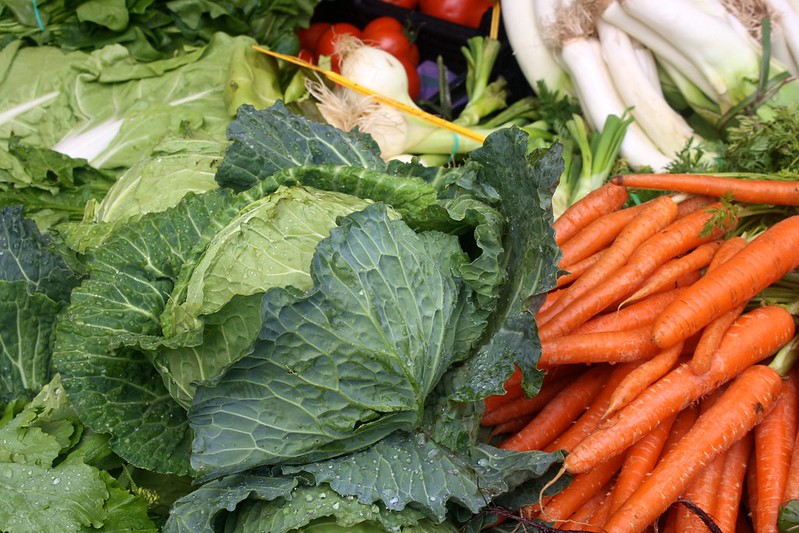
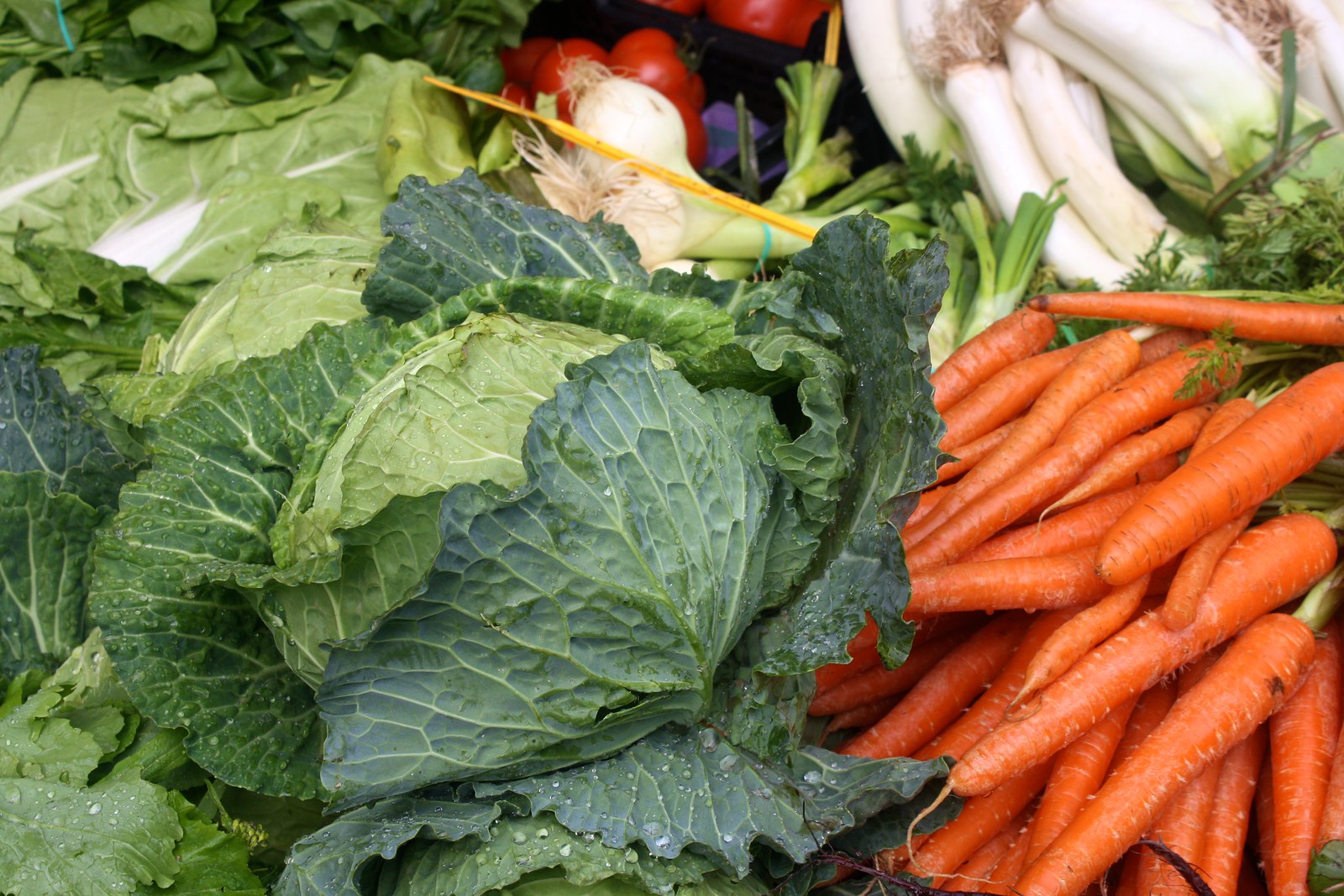 |
| Cabbage and carrots |
Santiago’s market is one of my favorite places in the entire city, mainly because a huge part of Galician culture is its delicious food, but also because I love eating, cooking, and supporting local producers rather than big chain supermarkets.
 |
| Tetilla cheese |
Although the current collection of eight granite halls was built in 1941, the farmers market has been held almost daily since the late 1800s in a location east of the cathedral on the edge of the historic old town. Bounded by the huge Church of Santo Agostiño to the north and the tiny Church of San Fiz de Solovio to the south, the market grounds house dozens of family businesses, offering every kind of local meat and produce you can think of.
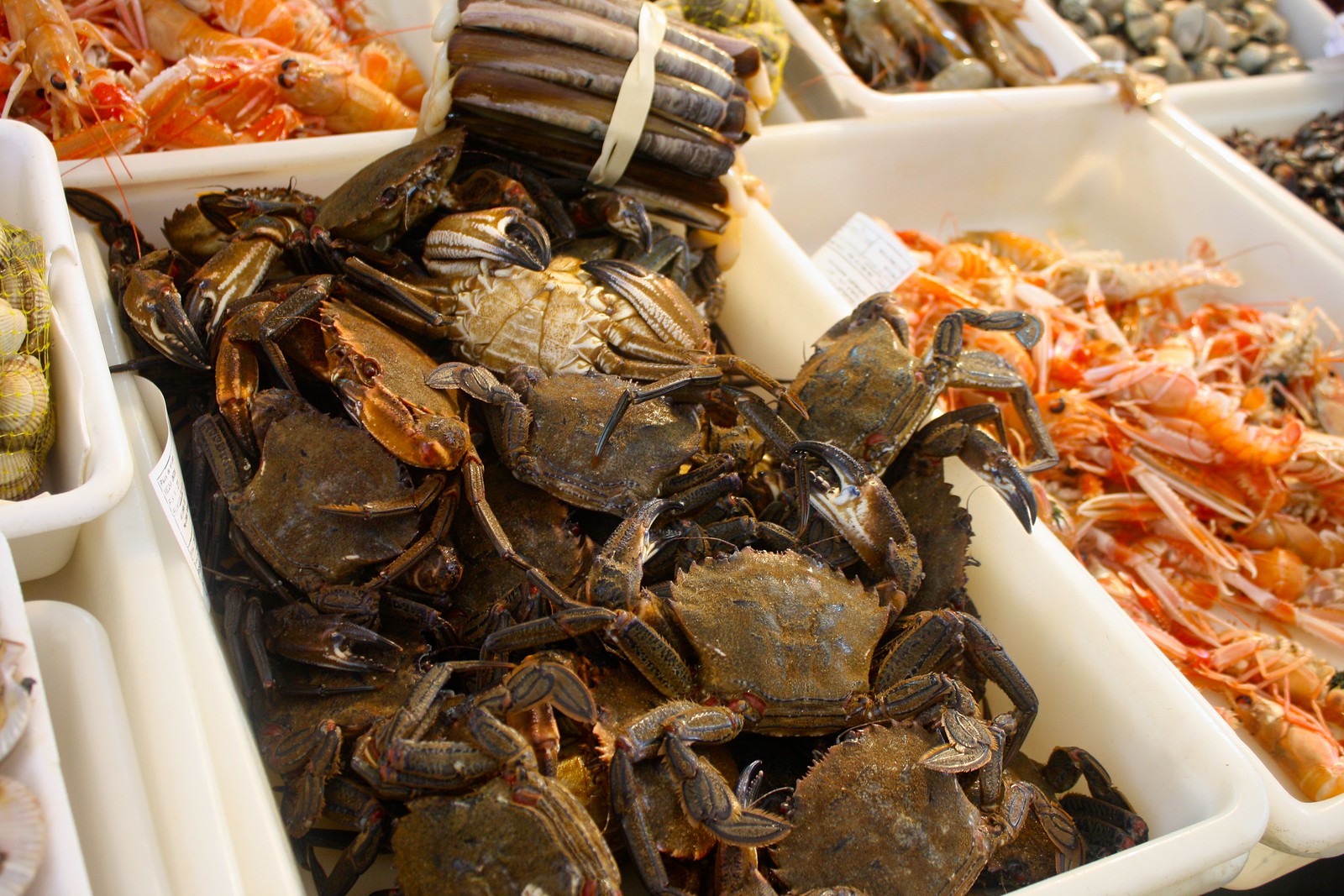 |
| Nécoras or velvet crabs |
The stalls generally fall into one of the following categories: seafood (mariscos), fruits and veggies (frutería), meat (carnicería), poultry and eggs (pollos), cheese and sausage (quesos/charcutería), bread and pastries (panadería), and salt cod (bacalao).
 |
| Selection of Galician liqueurs and spirits |
While you can find most of the same sorts of food in big-box supermarkets like Carrefour, Gadis, or Froiz, the selection and quality in the mercado blows the supermercados out of the water. At the very least. I try to buy my produce at the market rather than at grocery stores, because it’s so much easier to pick and choose a single carrot for a recipe rather than buying the only available bushel of them…plus, it’s kind of reassuring to buy potatoes and onions still dusty with soil.
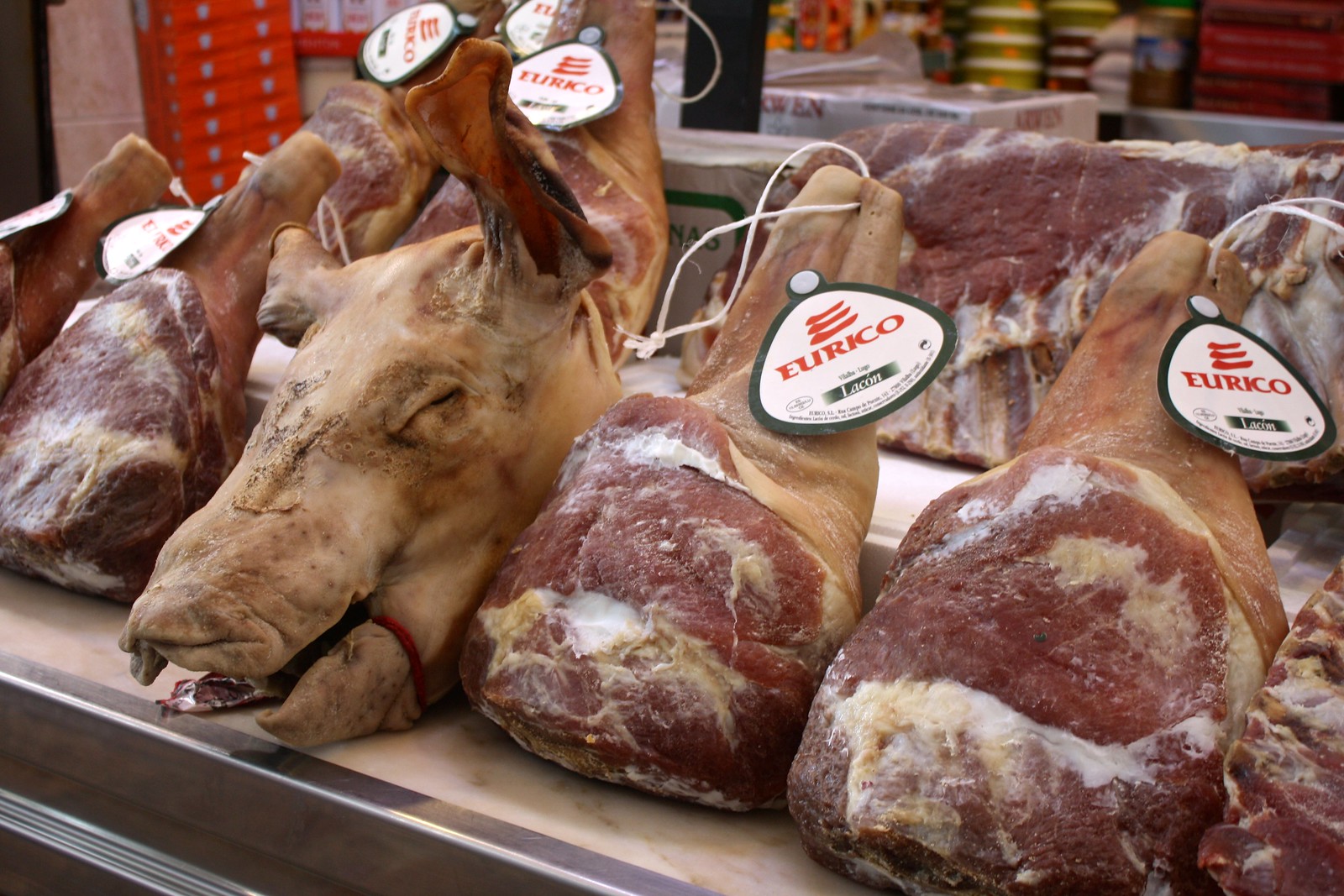 |
| Pork shoulder and pig head |
As far as seafood goes, there’s really no reason to buy anywhere else: from crabs to clams to fish to octopus, you’re gonna find the highest, freshest quality in the farmers market as well as the widest selection in the city. The fishmongers know their stuff and can help you out if you’re an ignorant landlubber like myself. Even if you’re not fond of seafood, it’s an exciting (and enlightening) experience to stroll through the seafood market and gape at the fascinating, colorful, and sometimes terrifying creatures of the deep.
 |
| Juicing oranges |
Something I like about the market a lot is that they have a little restaurant called Churro-Manía on the northwestern side that will, for the small fee of 4€, cook any food you buy—seafood or otherwise. It’s a great way to try the tempting Galician products you see in the shops but have absolutely no idea how to prepare, and if you’d love to order a mariscada or seafood platter in one of the touristy restaurants in the old town but would rather not shell out 35€ or more, you can “build your own” with what you want to eat and have them cook it for you right then and there.
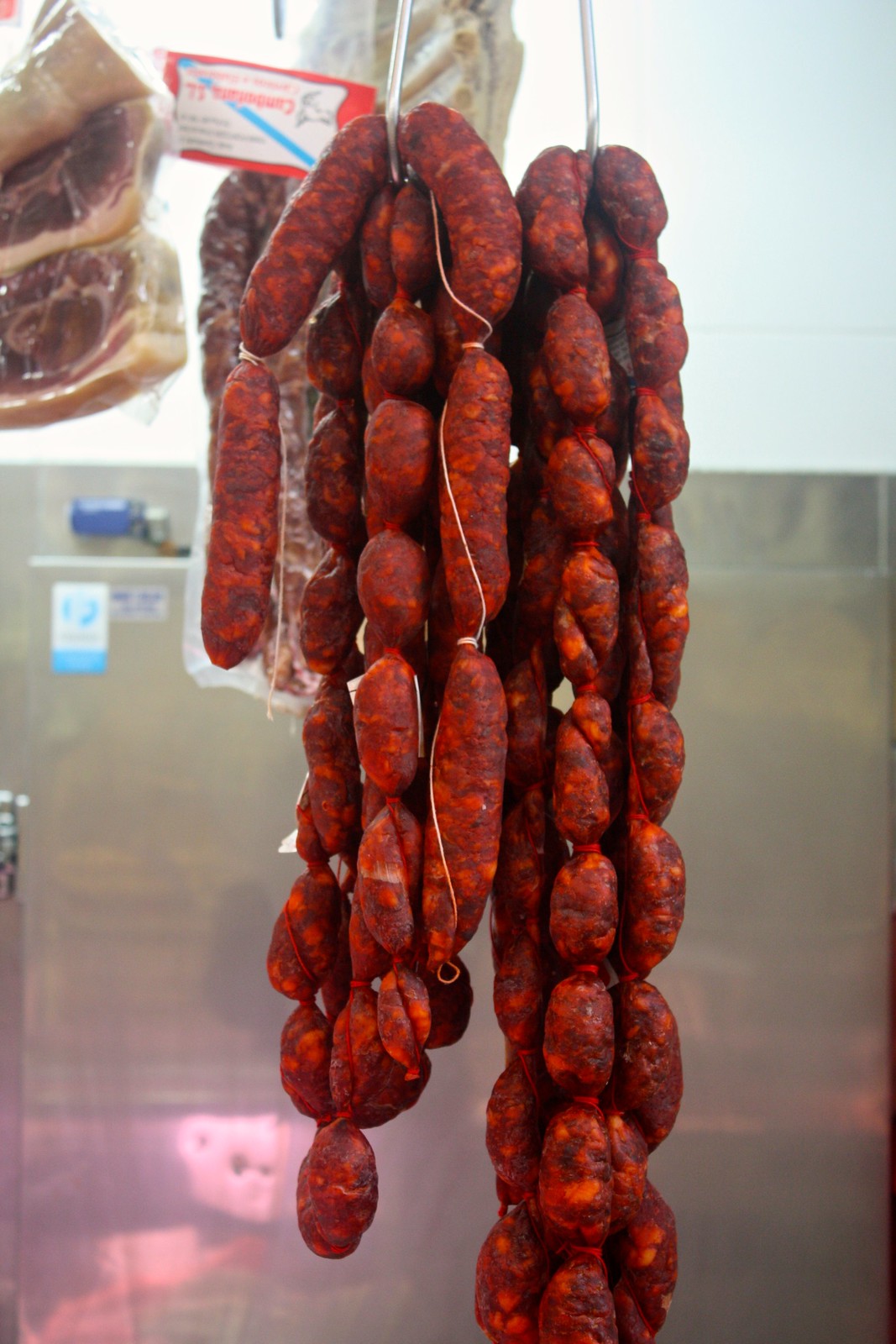 |
| Galician chorizo |
On the other side of the market, you can grab a quick bite to eat at Abastos 2.0, a “fridge-free” restaurant whose menu changes daily according to what looks fresh and appetizing that day. Plus, in the central common area, there’s almost always a guy working a huge copper pot where whole purple octopuses boil away. You can easily sample sliced medallions of this most typical of Galician seafood on round wooden plates, garnished with olive oil, salt, and smoked paprika.
How to get there
 |
| Among the naves or main halls |
Santiago’s Mercado de Abastos is located along the Rúa de Ameás on the eastern side of the casco viejo or historic old town. The Rúa da Virxe da Cerca runs below the hill to the east of the market, where almost all city buses make a stop. From the cathedral’s Praza das Praterías, head due east on either Rúa da Conga or Rúa de Xelmírez and keep a straight course.
The market is open Monday through Saturday from around 8am to 2pm, but the best days to shop are Thursdays and Saturdays. A handful of places stay open until 3 or so, but a lot of the seafood stalls start closing up shop around 1, so get there early for the best picks!
Do you prefer getting groceries at all-in-one supermarkets or farmers markets? Have you been to Santiago’s mercado before? Comment below!
